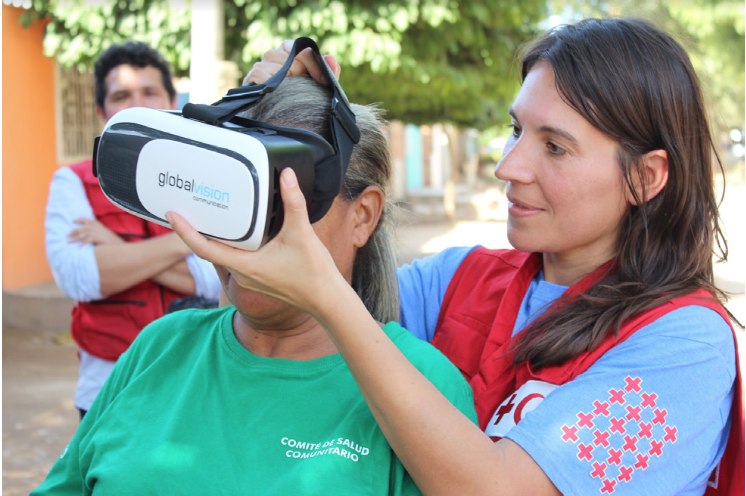Immersive Technologies & Digital Games

Red Cross Red Crescent National Societies across the world contribute to disaster risk reduction and preparedness in public schools. Typical school-based activities include disaster risk reduction, first aid, hygiene, health promotion, road safety and water sanitation. The activities are part of a series of recommended actions included under GADRRRES’ Comprehensive School Safety Framework, involving school disaster management and risk reduction and resilience education activities such as disaster awareness raising activities, disaster drills / simulations, and training.
Emerging extended reality (XR) technologies such as virtual reality, augmented reality and mixed reality have an enormous potential in the field of emergency management and disaster preparedness training and education. Recognising this, the GDPC presents a new research study exploring the benefits of implementing XR in these activities, to complement and enhance traditional approaches. The Red Cross Red Crescent Movement and partner organizations are increasingly using immersive technologies for a range of aims, including building empathy, fundraising, awareness raising and behaviour change. Examples of all of these are captured in this research.
The goal of the research is to provide information and options to all organisations globally interested in pursuing immersive technologies and serious gaming as a disaster preparedness educational tools. The research includes two parts: a meta analysis highlighting key learning points to be applied for future deployment of this type of technology for school and youth preparedness; and ten case studies which document the intersection of effective technologies and disaster risk reduction and preparedness education, capturing the breadth of innovative emerging technologies related to school safety and identifying good practices, effective approaches and technological features that support disaster preparedness programming in schools.
Gap analysis of School Based Disaster Risk Reduction (SBDRR) limitations & XR opportunities
Many traditional SBDRR methods of delivery are effective in conveying disaster knowledge and raising awareness of disaster management for children and adults. There are however a range of identified shortcomings in traditional methods of delivery and learning. The challenge of the main SBDRR activities – training, drills/simulations and awareness raising – often lies in conveying knowledge in an engaging and effective manner that can change behaviour while allowing for contextualisation and dissemination at a wide scale.
XR technologies have the potential to change teaching methodologies and overall reach, suplementing the already established practices and procedures applied in schools. Find some opportunities listed according to the key activities in SBDRR:
- Disaster awareness raising activities
- Disaster drills and evacuations
- Training (first aid and disaster management)

ZIKA360 is an innovative learning tool implemented by the International Federation of the Red Cross Red Crescent (IFRC) Regional office in America, to bring a new approach to the fight against the Zika virus. Find more case studies in the Research paper.
Disaster Risk Reduction
- Disaster Preparedness: The IFRC defines as: “measures taken to prepare for and reduce the effects of disasters. That is, to predict and, where possible, prevent disasters, mitigate their impact on vulnerable populations, and respond to and effectively cope with their consequences.”1
- Disaster Risk Reduction (DRR) “aims to reduce the damage caused by natural hazards like earthquakes, floods, droughts and cyclones, through an ethic of prevention.”2
- School based disaster preparedness or risk reduction is the application of the above in the school community and targets everyone involved in the teaching and learning activities (students, teachers, education personnel, support staff, headteachers).
Technology Definitions
- XR (extended reality): Extended reality, also known as cross-reality and hyper-reality, is an umbrella term that encompasses human-machine interactions generated by computer technology with devices or wearables to create real and virtual environments which include VR, AR, and mixed reality.
- Mixed reality (MR): Mixed reality is a hybrid definition combining both AR and VR.
- Virtual Reality (VR): Virtual reality is a technology that creates an immersive experience and content in most cases using a VR headset, a head-mounted display (HMD) or a fully immersive space. The current reality viewed by the user is replaced with a new computer generated environment in which the user is isolated from the real world.
- Augmented Reality (AR): Augmented reality is an immersive technology superimposing layers of digital content into the physical world to enhance the user’s real world experience.
- Serious Games (SGs): games whose primary purposes are training and education, rather than pure entertainment.
- Haptic technologies: Haptic technology, also known as kinaesthetic communication or 3D touch, refers to any technology that can create an experience of touch by applying forces, vibrations, or motions to the user.3
- Simulation: In science, a simulation is the creation of a model that can be manipulated logically to decide how the physical world works.4 Simulation has become the defacto design technique for all control systems design of today. In computers, a simulation (or “sim”) is an attempt to model a real-life or hypothetical situation on a computer so that it can be studied to see how the system works. By changing variables in the simulation, predictions may be made about the behaviour of the system. It is a tool to virtually investigate the behaviour of the system under study.5
- Avatar: refers to a representation or a manifestation of a particular person or character, usually used in video games, virtual experiences and internet applications. An avatar can be used to represent the self or other characters in the virtual space.
Sources:
- Disaster Preparedness, IFRC, website.
- Disaster Risk Reduction, UNISDR, website.
- Haptic technology, Wikipedia, website.
- Gran, Richard. What is simulation?, MatLab-YouTube.
- Banks, J; J. Carson; B. Nelson; D. Nicol (2001). Discrete-Event System Simulation.
https://preparecenter.org/wp-content/sites/default/files/topics/gdpc_xr_fullresearch.pdf
